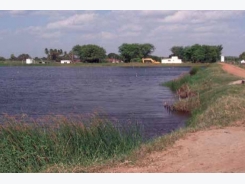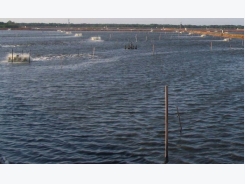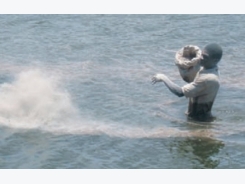Salinity Balance Key To Culture Success

Like some other penaeid shrimp, P. monodon can tolerate a wide salinity range
Summary:
Aquaculture species are adapted to optimal salinity ranges. Outside these ranges, they have greater feed-conversion ratios, grow at slower rates, be- come stressed and susceptible to disease, or even die. Proper monitoring and controlling of salinity to maintain osmotic balance between pond water and the internal body fluids of culture animals are there- fore essential.
Salinity in water results from the presence of dis- solved ions. Eight major ions comprise most of the salin- ity. The positively charged ones, called cations, are calci- um, magnesium, sodium, and potassium. The negatively charged ions, or anions, are chloride, sulfate, bicarbon- ate, and carbonate. Bicarbonate and carbonate usually are considered together, for water with pH below 8.3 does not have carbonate, and at higher pH values, some of the bicarbonate changes to carbonate.
Salinity often is reported in parts per thousand (ppt), where 1,000 mg/l = 1 ppt. Freshwater usually is consid- ered to have less than 1 ppt salinity. The salinity of sea- water averages 34,560 mg/l (Table 1). The world average salinity of river water is approximately 120 mg/l.
Measuring Salinity
Salinity can be measured by determining ionic con- centrations and adding their values. However, in saline waters, it usually is estimated from the relationships be- tween salinity and density, electrical conductivity, or re- fractive index.
There also is a close relationship between chloride concentration and salinity in marine and estuarine wa- ters. A good approximation of salinity can be obtained by multiplying chloride concentration in milligrams per liter by 1.8.
In freshwater, the total dissolved solids concentration usually provides an excellent estimate of salinity. Total dissolved solids are measured by evaporating water and weighing the residue of salts. The hydroscopic nature of salts prevents the use of this technique in saline water of medium to high salinity.
Electrical conductivity also can be used to estimate the salinity of freshwater. The variations in ionic compo- sition in freshwater are much greater than in brackish water or seawater. Different ions contribute differently to electrical conductivity, which affects the relationship between conductivity and salinity.
Effects on Aquatic Organisms
Salinity has a major impact on aquatic organisms be- cause of the relationship of salinity to osmotic pressure. Osmotic pressure is a colligative property of solutions that can be visualized by considering two solutions of dif- ferent salinities separated by a semipermeable mem- brane that allows water molecules to pass between the so- lutions, but blocks ions and other solutes.
On the side of the membrane facing the more concen- trated solution, the membrane is struck by more solute particles than on the other side. Thus, more water mole- cules pass from the dilute solution to the concentrated so- lution than in the other direction. The net movement of water molecules to the less concentrated side continues until the two solutions have equal concentrations of ions. Consider that a piston could be placed above the con- centrated solution and enough pressure applied to stop the movement of water to the concentrated side. This pressure would equal the osmotic pressure of the solu- tion, which also can be calculated for the concentration of the solute.
Aquatic animals’ outer surfaces can be thought of as semipermeable membranes between their body fluids and the external environment. Body fluids have salt con- centrations of around 9,000 mg/l. Thus, the fluids of freshwater aquatic animals usually are more concentrat- ed in ions and other particles than the surrounding water. When water enters the animals, they must excrete water and retain ions and other particles to maintain their normal internal pressure.
Table 1. Concentrations of major ions and salinity in seawater and world average river water.
| Variable | Seawater (mg/l) | River Water (mg/l) |
| Chloride | 19,000 | 7.8 |
| Sodium | 10,500 | 6.3 |
| Sulfate | 2,700 | 11.2 |
| Magnesium | 1,350 | 4.1 |
| Calcium | 400 | 15.0 |
| Potassium | 380 | 2.3 |
| Bicarbonate/ carbonate | 142 | 58.0 |
| Salinity | 34,560 | 120.0 |
Marine organisms have lower concentrations of ions in their body fluids than occur in seawater. Thus, they lose water to the outside, and must take in water and ex- crete ions to maintain normal internal pressure.
When freshwater fish are exposed to increasing salin- ity, they must use energy to take in water and excrete ions. Since this energy must be deducted from that de- rived from the food they consume, less energy will be available for growth and other purposes. Likewise, when marine organisms are placed in low-salinity water, they use additional energy to compensate for the lower con- centrations of ions in the water surrounding them.
Aquaculture Relevance
Aquaculture species are adapted to certain optimal salinity ranges. Outside these ranges, they have greater feed-conversion ratios, grow at slower rates, become stressed and susceptible to disease, or even die. The rela- tionship between salinity and the recovery of food ener- gy in growth for common carp is illustrated in Table 2.
Table 2. Effect of salinity on utilization of food energy in common carp (Wang et al., 1997).
| Salinity (ppt) | Food Energy Recovered As Fish Growth (%) |
| 0.5 | 33.4 |
| 2.5 | 31.8 |
| 4.5 | 22.2 |
| 6.5 | 20.1 |
| 8.5 | 10.4 |
| 10.5 | -1.0 |
Some species can adapt to wider ranges in salinity than others. Marine shrimp are particularly tolerant of vary- ing salinity. For example, Litopenaeus vannamei and Pe- naeus monodon are cultured in waters ranging from 1 ppt to more than 40 ppt. However, extreme salinities are stressful, and shrimp culture is less problematic at salini- ties above 5 ppt and below 40 ppt. Extreme salinities are especially stressful when temperatures also are extreme.
Shrimp farms in estuaries often have wide seasonal variations in salinity. During the rainy season, salinity can fall drastically, while during the dry season, salini- ties may exceed those of ocean water.

Depending on the season, aquaculture farms in coastal regions can experience wide variations in pond water salinity.
Inland Regions
There currently is considerable interest in growing marine and estuarine species in low-salinity water in in- land regions. For species such as striped bass, the salini- ty of water has been increased by adding rock salt to freshwater ponds. In Thailand, brine solution of 100-200 ppt salinity from coastal evaporation has been placed in freshwater ponds to raise salinity and allow marine shrimp culture. In some other places, groundwater or surface water with adequate salinity is available.
Although these waters have adequate salinity, imbal- ances among their major ions can affect the growth and survival of fish and shrimp. The most notable problem has been low potassium concentration. This issue has been overcome by applying potassium chloride to provide a potassium concentration equal to 10 times the salinity. Low magnesium concentrations can also negatively affect the growth of culture species in low-salinity water.
In arid climates, evaporation concentrates the ions in inland pond water, which can harm culture species, es- pecially where lined ponds are used and water is applied regularly to replace evaporation losses. I am aware of a situation where the salinity in a lined pond in a desert area rose above 5,000 mg/l over several years, which killed the largemouth bass stocked in the pond.
Shrimp farmers sometimes add freshwater to coastal ponds to lower salinity. Withdrawal of groundwater for this purpose is not recommended, for it can lead to salt water intrusion into the freshwater aquifer.
Related news
Tools

Phối trộn thức ăn chăn nuôi

Pha dung dịch thủy canh

Định mức cho tôm ăn

Phối trộn phân bón NPK

Xác định tỷ lệ tôm sống

Chuyển đổi đơn vị phân bón

Xác định công suất sục khí

Chuyển đổi đơn vị tôm

Tính diện tích nhà kính

Tính thể tích ao




 Specific Conductance – Alternative Salinity Measurement
Specific Conductance – Alternative Salinity Measurement  Carbon Dioxide: Waste, Nutrient
Carbon Dioxide: Waste, Nutrient